SDR (SOFTWARE-DEFINED RADIO)
I Z33T home page I Z33T web pages in english I
Software-defined radio (SDR) is a radio communication system where components that have been typically implemented in hardware (e.g. mixers, filters, amplifiers, modulators, demodulators, detectors etc.) are instead implemented by means of software on a personal computer, lap-top, tablet or mobile phone.
Software-defined radio using analog-to-digital converter (ADC) and some form of input RF cirquit (for SDR-receiver), or input-output circuit (for SDR transceiver).
Some SDR devices using sound card of the PC as analog-to-digital converter, but many of the newer SDR devices have their own hardware ADC, and they uses the PC for runing the software through which implements the remaining stages of digital signal processing (DSP), as demodulation (CW, AM, SSB, LSB, USB, DSB, FM, WFM, NFM...) and all necessary filters for receiving or transmitting.
In the Software Defind Radio usually the very wide frequency portion (can be more MHz wide) is digitized by analog-to-digital converter (ADC). Once the signal is digitized, software can control the channel frequency, filter bandwidth, modulation format and other digital signal processing (DSP).
Digital signal processing (DSP) can be implemented at RF-signal, IF-signal, or after demodulator, at the audio signal (AF). SDR market grows up from day to day. There are SDR-receivers only, or complete SDR transceivers for different frequency bands. There are very cheap SDR-s and quite expensive SDR-s according to their quality and their features.
The SDR receiver performance depends of many factors. One of the most important factors that directly affect the SDR receiver performance is dynamic range of the analog-to-digital converter utilized.
The dynamic range of the analog-to-digital converter is the relation between the strongest signal and weakest signal (noise floor) that can be digitized without distortion.
More about SDR Dynamic Range you can find on my page "SDR-Dynamic Range"
RTL-SDR
One of the most popular SDR device is certainly RTL-SDR. Its popularity is undoubtedly due to the very low price. There are several varieties, with the price ranging from just a few dollars, up to seventy or so dollars. In general the quality is almost identical. Lowest price RTL-SDR`s haven`t rock stable frequency, but still enough stabile to compare to cheaper amateur`s receivers or transceivers. More expensive ones have TCXO (temperature-compensated crystal oscillator) and their frequency stability is as the most expensive amateur and professional communication transceivers that cost thousands of dollars.
All newer variants of the RTL-SDR is having identical tuner "Rafael Micro" R820T or newer R820T2 tuner chip that can operate in the frequency range 24 to 1760 MHz.
Another common element of all variants of the RTL-SDR is "Realtek" RTL2832 chip, which acts as a demodulator, 8-bit analog-to-digital converter and USB 2.0 interface.
RTL-SDR device, are originally designed and produced as a USB receiver for digital terrestrial TV reception (DVB-T = Digital Video Broadcast - Terestrial) for use with a laptop computer. Ingenious radio amateurs found that this cheap USB DVB-T tuner, with appropriate software, can be used as a universal communication receiver for all kinds of modulation in the frequency range from 24 to 1760 MHz. The sensitivity of RTL-SDR is excellent and can be compared to the most expensive communications receivers on the market. The downside of this inexpensive SDR device is small dynamic range of anout 50 dB, which is limited with its 8-bit analog-to-digital converter.
More about this ultra-cheap and mega-popular SDR receiver, you can find at this link.
You can see the schematic of RTL-SDR on following pictures. The first one is front-end schematic with elements around R820T tuner chip. The second one is schematic with elements around RTL2832 chip:
click on one of above pictures to see it in high resolution
There are some RTL-SDRs on the market which have the option of receiving HF frequencies below 24 MHz using direct sampling. However, I recommend to avoid these varieties because these models have an RF transformer connected directly to the input pins of RTL2832 chip, skipping the tuner R820T and enabling HF receiving.
This method has many disadvantages. There are many phantom signals and spurs. The frequency-amplitude dependence is not linear. Besides, the RTL-SDRs with this modification have no protection to the RTL2832 chip from excessive voltage which can occur on its input pins, so it can easily been destroied.
For short-wave receiving, it is best if you use a separate external RF up-converter, which converts (transfers) the HF signals to a higher frequency range where they can been receive with the RTL-SDR. Quality RF converters have filters to eliminate all possible frequencies that can interfere with the reception of the desired signals in the range of about 10 kHz to 50 MHz depending of the up-converter.
More details about these up-converters you can read here.
How good is the RTL-SDR receiver in comparison with modern amateur communications transceiver?
On this question you will be able to provide an answer once you look at my videos in which I compare the RTL-SDR versus modern Kenwood TS-480 transceiver, during the WAE DX SSB Contest, using the same antenna, in the same conditions.
In the first video, the comparison was made at 14 MHz band, while receiving the signal from radio station in the presence of very strong signals close to it. You can see this video here.
In the second video, comparison was made on 7 MHz band. You can see it here.
AIRSPY SDR
Airspy is excellent SDR-receiver for frequency range from 24 MHz to 1800 MHz. It has 12 bit analog-to-digital converter and excellent dynamic range. For HF, LF and VLF (5 KHz do 55 MHz) receiving, there is an RF converter "SpyVerter" which produces by the same company as the basic Airspy unit. Its price is much more expensive than RTL-SDR (cost about $ 199), but the quality of Airspy worth every penny you spend to buy it. This is one of the best receivers on SDR-market up to 500 dollars. The Airspy SDR is designed by Youssef Touil, creator of one of the most popular SDR software "SDR #" with a wide range of possibilities.
Besides "SDR #", Airspy can work with some other popular free software such as HDSDR, SDR-Radio Console etc.
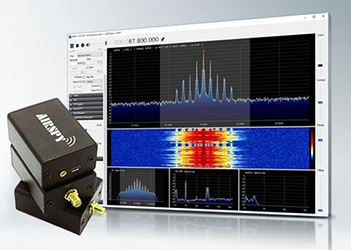
To increase the dunamic range, Airspy using "decimation" described on my webpage which explains the dynamic range.
During the WAE DX SSB Contest I have made comparison between Airspy SDR + Spyverter on one side, and one modern communication transceiver, Kenwood TS-480 DSP on the other side, on 14 MHz (20 meters band), with the same antenna at the same time. There was Japanese radio amateur station (JH4UTP) working on the contest with relatively weak signal in Macedonia, in presence of Strong signals around. A really chalenge situation for radio receiver dynamic range. You can check the recorded video of this comparison here.
To check the Airspy performance on VHF, I have made comparison between Airspy and two excellent HI-Fi FM tuners, but also with a cheap RTL-SDR, receiving weak signal on FM broadcast band in presence of the extemely strong local FM stations. In such hard conditions, the dynamic range of the receiver (not his sensitivity) is crucial to whether a weak signal can be received at all, due to huge interference from strong signals near by. You can check the recorded video of this comparison here.
At the end of 2017, Airspy team have been lounched a new SDR receiver named Airspy HF+ :
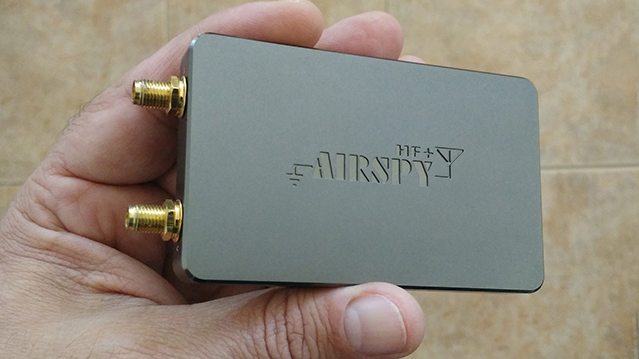
The Airspy HF+, works on VLF to HF and also in VHF. It covers 9 kHz to 31 MHz, and 60 to 260 MHz, with excellent dynamic range and +15 dBm IP3 on HF at maximum gain.
More information about this great SDR-receiver, you can find on Airspy official website.
SDRplay (RSP1)
SDRplay is also very popular and quality SDR-receiver. Its price is cheaper than Airspy, cost about 129 dollars, and the quality is slightly lower than Airspy, but it can receive all frequencies from 10 kHz 2000 MHz and do not need an external RF converter. SDRplay`s 12-bit analog-to-digital converter dynamic range is slightly lower than that of Airspy, but many, many times higher than the dynamic range of the RTL-SDR.
The price includes the specially designed software named "SDRuno". Of course, SDRplay can work with other free software such as HDSDR, SDR-Radio Console and others.
To check the HF performance of this SDR receiver, I have made a video comparison of SDRplay versus popular transceiver Kenwood TS-480 during a contest at 7 MHz, receiving a weak signal from a Japanese amateur station JH1EAQ, in the presence of very strong radio signals around. You can check this video comparison here.
On november 2016, SDRplay anounced their new SDR receiver "RSP2" with tri software selectable antenna inputs. Two inputs with SMA connectors (50 ohm impedance) for frequencies higher than 1,5 MHz, and one Hi-Z connector for frequencies down to few kHz.
Basically RSP1 and RSP2 have the similar architecture. RSP2 has band-stop filters but not on Hi-Z input which is used for frequencies below 1,5 MHz. But overall RSP2 has more features... On SMA antenna ports of RSP2, when you receiving HF, band-stop filters could wipe-off interference from AM BC band as well as from FM BC band and it is useful feature. On the other hand this feature can not be used with Hi-Z antenna port for receiving below 1.5 MHz. Many users will find the opportunity to select the antenna inputs via software very useful. The bias-T on RSP2 is good feature too.
On November 2017, SDRplay have been lounched a new SDR-receiver named RSP1A :
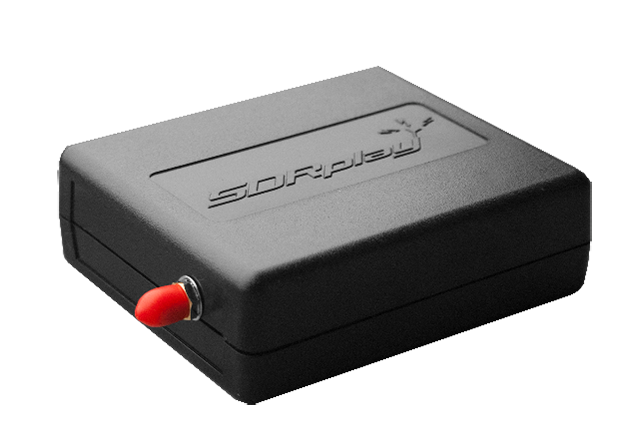
The SDRplay RSP1A is a major upgrade to the popular RSP1—it is a powerful wideband full featured 14-bit SDR which covers the RF spectrum from 1kHz to 2GHz. All it needs is a PC and an antenna to provide excellent communications receiver functionality. Combined with the power of readily available SDR receiver software (including ‘SDRuno’ supplied by SDRplay) you can monitor up to 10MHz of spectrum at a time.
On May 2018, SDRplay have been lounched teh RSPduo, SDR receiver with two tuners inside:
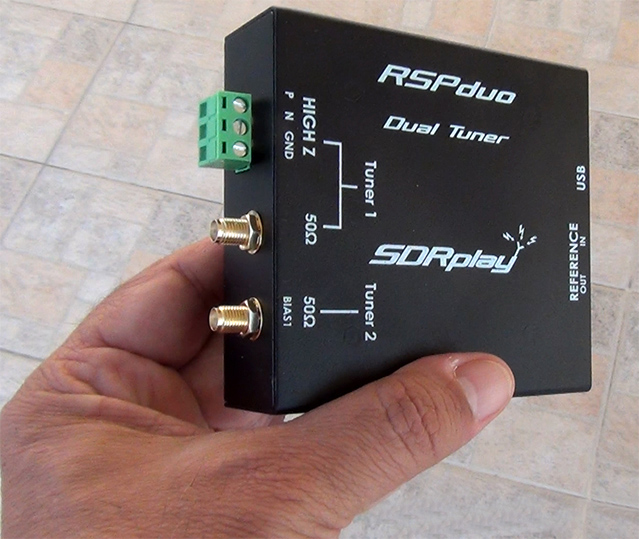
The RSPduo is a dual-tuner wideband 14-bit SDR receiver which covers the entire RF spectrum from 1kHz to 2GHz giving up to 10MHz of spectrum visibility. Combined with the SDRuno software, this SDR receiver with its two totally independent tuners, can simultaneously receiving, monitoring and recording two separate 2MHz bands of spectrum, anywhere between 1kHz and 2GHz.
In single tuner mode, RSPduo can receive, monitor and record up to 10 MHz of spectrum at a time.
The RSPduo provides three software selectable antenna inputs. All it needs is a PC and an antenna to provide excellent communications receiver functionality.
The RSPduo Covers all frequencies from 1kHz through VLF, LF, MW, HF, VHF, UHF and L-band, up to 2GHz, with no gaps.
This quality SRD receiver has 14-bit Analog to Digital Converter with excellent dynamic range, and definitely it is not another 8 bit USB-dongle.
More information about this great SDR-receiver, you can find on SDRplay official website.
Here is interesting SDR setup with SDRplay and android mobile phone:
(click on the picture to watch the video)
You can turn your mobile phone into an All mode SDR communications receiver from 0.1 to 2000 MHz !
This video shows "SDRplay" Software Defined Radio running with my Android mobile phone, receiving USB on 20m Band (14 MHz).
The software "SDR Touch" and SDRplay driver are downloaded from Google Play Store. There is a driver for RTL-SDR also!
Some mobile phone USB ports simply do not have enough power for the SDR receiver (my phone usb port, did not provide enough power also), therefore, I sliced the USB OTG cable and added (soldered) additional connector for an external 5 volts power source, or 5V battery pack. In that way, the external battery is charging the mobile phone and powering the SDRplay-receiver at the same time.
ColibriNANO SDR-receiver
The Colibri-NANO USB stick is a powerful direct sampling SDR receiver with frequency range from 10 kHz to 55 MHz. ColibriNANO is not another cheap USB dongle found on e-bay, this high quality SDR receiver has been developed by Expert Electronics and features a solidly build aluminum chassis, 15 kV Electrostatic discharge (ESD) protection, USB 2.0 interface and a quality SMA antenna connector.
The Analog-to-Digital Converter (ADC) uses 14 Bit, which results in an excellent 110 dB Blocking Dynamic Range (BDR). The sample rate is 122.88 MHz and together with the Low-pass filter offers a direct samplig receiver up to 55 MHz. The filter can be turned off so you can use the receiver in undersampling mode up to 500 MHz. In that case external filters and preamlifier (like the 2m filtered preamplifier from the same producer) is recommended for maximum results.

Another nice feature of the ColibriNANO SDR is the combined attenuator/pre-amp stage which can be fine-adjusted in 0.5 dB steps from -31 to +6 dB. Together with the low noise floor (-127 to -131 dBm) and an excellent sensitivity of 0.05 µV, the result is a receiver with excellent large signal handling capabilities. The ColibriNANO is a perfect HF scanner.
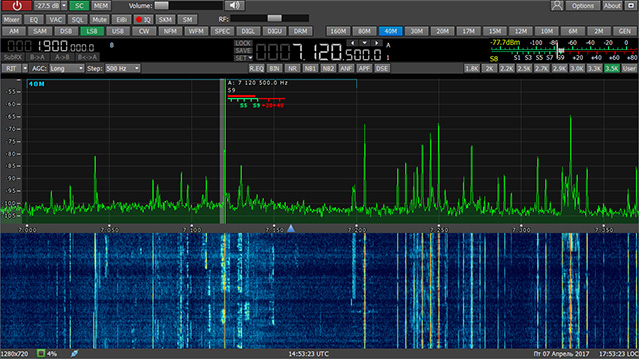
The Colibri-NANO can be operated directly attached to the computer of the user, or can be used remotely at a distant location. This is done with the freely available ExpertRemote software. At the location of the SDR a small computer is required (for example a Raspberry-Pi) and for the internet connection can be used a relatively slow link (LTE or 3G is sufficient).This allows you to use the SDR receiver at a convient and quiet location anywhere on the world.
Expert Electronics company developed the ExpertSDR2 software to control HAM radio equipment of its own design. Software version for the ColibriNANO allows you to harness all the potential of the receiver: remote operation, synchronization with the transceiver, IQ channel bandwidth up to 3 MHz, control of the preamplifier and LPF.
Remote operation with the ColibriNANO receiver
To control the ColibriNANO via Internet you need freely available ExpertRemote system, based on the client-server connection. This system allows you to place the receiver and server in the remote location with low RF-noise and with Internet connection. This might be some remote village or place with no electrical interference and 3G/4G Internet (or any other connection type). Using the ExpertRemote system you can enjoy in clear noiseless reception from your phone, tablet, notebook or PC. Even simple antennas, placed in a "quiet" place, allows you to listen weak signals from the DX-stations better than in urban area filled with all kind of RF-noise.
Another feature of this system is that the receiver's software can be synchronized with transceivers and be used as the panorama adapter with high resolution. In that way uopi can use the transceiver to transmit signals, and receive on your remotely located receiver via the ExpertRemote system.
The ColibriNANO can be used with third party software like HDSDR etc.
You can watch my ColibriNANO video review on YouTube here.
Here is a good video of ColibriNANO SDR with ExpertSDR2 software in serious CW receiving during hard contest conditions
More information about this great 14 bit SDR-receiver, you can find on Expert electronics official website.
SOFTWARE for SDR devices
There are many computer programs that are designed for SDR devices. Most of them are universal and can work with different SDR units, but some are made specifically for SDR device with whom they are sold together in a package. My choice is the following, which I think are the best:
SDR # (SDRsharp) - This free software can be downloaded from here.
click ot the picture above to see it in high resolution
The SDR# software is designed by Youssef Touil, creator of one of the most popular SDR-receivers "Airspy", with a wide range of possibilities. This software has many plugins which are made by other companies or individuals. They can be optionally downloaded for free, and can extend the capabilities of the basic software. In the same package with SDR#, there is a great software tool named "SpectrumSpy" that enables Airspy to be used as a wide range spectrum analyzer. With this tool, the whole frequency range up to 1800 MHz, or particulary parts, can be displayed on the computer screen almost at real time. In that way, with addition of cheap noise generator, it can be used for characterising RF-filters, amplifiers, and other RF-components. We can add the directional coupler to this setup and "get poor man's Network Analyzer" and antenna analyzer. You can see this as my project here.
SDR# software is updated regularly and frequently.
HDSDR - This free software can be downloaded from here.
click ot the picture above to see it in high resolution
HDSDR is a great software especially for SDR receivers or transceivers for short waves. Unfortunately, it has no possibility for the reception of FM broadcasting stations because there is no support for WFM type of modulation, but it support NFM, which is used for FM VHF / UHF radio communications used by radio amateurs and some other communication services. Latest version of the HSDR software is v.2.70 from November 2013. Nevertheless, this is one of the best and most complete SDR-software. HDSDR is very stable and therefore I recommend it as a classical software for SDRs.
Latest news: after 3 years pause, in november 2016, new beta version of this excellent HDSDR software pop up! The good thing is that the author is on the road again!
SDR-Radio Console- This free software can be downloaded from here.
click ot the picture above to see it in high resolution
Another excellent Windows based program for SDR receivers or transceivers. It has a powerful graphical interface with many useful features and tools. This software is updated regularly. With each new version is better and better. It can simultaneously engage up to 6 independent tuners (VFOs). Each virtual receiver can run on the same or a different frequency, the same or different modulation and the same or different settings of the filters. Supports working with multiple monitors. SDR-Radio Console works with almost all popular SDR devices.
SDRuno - This free software can be downloaded from here.
click ot the picture above to see it in high resolution
SDRuno software is based on the famous paid SDR software "Studio-1", which was selling at a price of about 150 euros. In spring 2016, the company that produces SDR receiver SDRplay (RSP1) announced that it have acquired the license to adapt this software to its product and now offers it free under the name "SDRuno", for those who buy or have already bought their SDRplay. Inside the main software, can be swithed-on multiple independent software virtually receivers. One vitual receiver can receive SSB on some frequency for example, the other receiver can receive CW on another frequency and so on. Each virtual receiver can run on the same or a different frequency, the same or different modulation and the same or different settings of the filters. SDRuno software is updated regularly.
- - - - - - - - - - - - - - - - - - - - - - -
What makes a good SDR?
RTL-SDR.COM makes excellent review for few popullar SDR`s.
Here are some highlights from this article about most important SDR characteristics:
SNR – When receiving a signal the main metric we want to measure is the “Signal to Noise” (SNR) ratio. This is the peak signal strength minus the noise floor strength.
Bandwidth – A larger bandwidth means more signals on the screen at once, and more software decimation (better SNR). The downside is that greater CPU power is needed for higher bandwidths.
Alias Free Bandwidth – The bandwidth on SDR displays tends to roll off at the edges, and also display aliased or images of other signals. The alias free bandwidth is the actual usable bandwidth and is usually smaller than the advertised bandwidth.
Sensitivity - More sensitive radios will be able to hear weaker stations easier, and produce high SNR values.
ADC – Analogue to digital converter. The main component in an SDR. It samples an analogue signal and turns it into digital bits. The higher the bit size of the ADC the more accurate it can be when sampling.
Overloading – Overloading occurs when a signal is too strong and saturates the ADC, leaving no space for weak signals to be measured. When overloading occurs you’ll see effects like severely reduced sensitivity and signal images.
Dynamic Range – This is directly related to ADC bit size, but is also affected by DSP software processing. Dynamic range is the ability of an SDR to receive weak signals when strong signals are nearby. The need for high dynamic range can be alleviated by using RF filtering. Overloading occurs when a strong signal starts to saturate the ADC because the dynamic range was not high enough.
Images/Aliasing – Bad SDRs are more likely to overload and show images of strong signals at frequencies that they should not be at. This can be fixed with filtering or by using a higher dynamic range/higher bit receiver.
Noise/Interference – Good SDRs should not receive anything without an antenna attached. If they receive signals without an antenna, then interfering signals may be entering directly through the circuit board, making it impossible to filter them out. Good SDRs will also cope well with things like USB interference.
RF Filtering/Preselection – A high performance SDR will have multiple preselector filters that switch in depending on the frequency you are listening to.
Center DC Spike – A good SDR should have the I/Q parts balanced so that there is no DC spike in the center.
Phase Noise – Phase noise performance is determined by the quality of the crystal oscillators used. Lower phase noise oscillators means better SNR for narrowband signals and less reciprocal mixing. Reciprocal mixing is when high phase noise causes a weak signal to be lost in the phase noise of a nearby strong signal.
Frequency Stability – We should expect the receiver to stay on frequency and not drift when the temperature changes. To achieve this a TCXO or similar stable oscillator should be used.
RF Design - The overall design of the system. For example, how many lossy components such as switches are used in the RF path. As the design complexity increases usually more components are added to the RF path which can reduce RX performance.
Software – The hardware is only half of an SDR. The software the unit is compatible with can make or break an SDRs usefulness.
I Z33T home page I Z33T web pages in english I